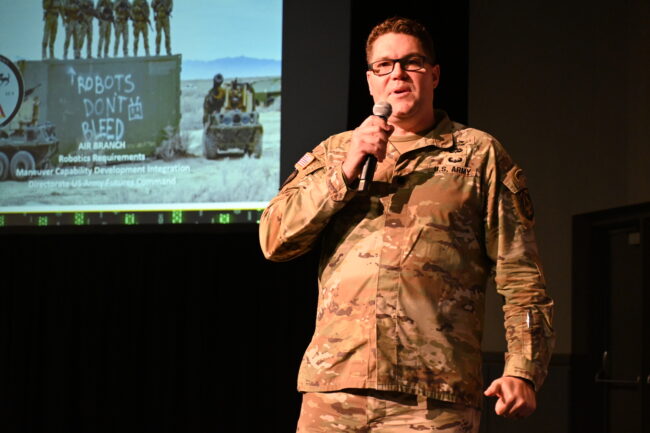BRETT DAVIS

HUNTSVILLE, Alabama—Russia’s invasion of Ukraine, and Ukraine’s furious response to it, have opened the eyes of militaries around the world to the role small UAS can play in warfare, an Army requirements chief said.
That includes the U.S. Army, which is looking for ways to do SUAS warfare better.
“The first thing I do in the morning, I wake up, roll out of bed, have my coffee and I’m on the Telegram app looking at open-source intelligence of what’s going on in drone warfare, both from the Russian and the Ukrainian side, as well as non-state actors around the world,” said Lt. Col. Michael Brabner, the Air Branch Chief in the Maneuver Capability Development Integration Directorate’s Robotics Requirement Division.
His team is writing requirements for seven SUAS programs under the Joint Small UAS architecture, including the short-, medium- and long-range reconnaissance systems, tethered UAS and first-person view systems.
“We’re trying to look to not only change doctrine, how we’re going to fight in the future, just kind of emulating what we’re absorbing watching Ukraine and Russia right now…,” he speaking at the AUVSI Pathfinder chapter annual conference earlier this week.
Reports have indicated Ukraine having three out of five drones shot down, losing up to 10,000 of them a day. “Those are commercial, off-the-shelf DJI drones, they’re not connected to a mesh network, they’re not connected to ATAC, they’re not utilizing our tactics, our doctrine, so we can do it better,” he said.
Replicator
Deputy Defense Secretary Kathleen Hicks on Aug. 28 unveiled a program named Replicator, intended to field thousands of autonomous, disposable systems across multiple domains. Although the program is aimed at countering China, Hicks referenced the role cheap drones have played in the war in Ukraine, according to press reports.
“We’re very happy to see everything we’re doing that senior leadership are starting to wake up to,” Brabner said of the Replicator program. “If you’re reading that article [about the Hicks announcement], you’re kind of seeing the dollar bills that are starting to get thrown behind small UAS.”
Brabner said, “I typically said the small UAS portfolio in PEO Aviation is the black sheep. Well, now they’re starting to say, hey, I can utilize robotics to not only make contact, maintain contact, and then flip that paradigm. We all remember IED alleys and how we were subject to a time and place of the enemy’s choosing. Now, with robotic-enabled maneuver, and small UAS, we can kind of flip that paradigm on our enemies, and then go back to actually owning the night.”
Most of the videos coming out of Ukraine and Russia are shot in the daytime, he noted. “Given an advanced EO/IR [electro-optical/infrared] sensor on that thing, and now we really own the night. So now we have a sensor with NVG [night vision goggle] thermal capabilities going out there doing our hunting for us.”
The U.S. isn’t the only country paying close attention to the use of small drones. Brabner said Russia has changed the way it uses some of the SUAS.
Doctrinal Change
“I sat in a brief yesterday and it was going over how Russia just changed their doctrine. How easy is it to change doctrine? Kind of a tectonic, glacial process, right? So, everybody remembers the Russian doctrinal TTP [tactics, techniques and procedures] of, blanket everything with artillery. 200-plus rounds. Just get a general grid location and fire for effect. They’ve pulled reconnaissance out of their maneuver elements. Guess where they put it? In their artillery battalions…so, now you have artillery reconnaissance with small UAS,” he said. “Going out there to find that target so you can get those coordinates and then fix them, and you’re going from shooting 200-plus rounds to shooting 30 rounds.”
Harkening back to what Hicks said about Replicator and its usefulness against China, Brabner said China has more small UAS than the United States, and getting more SUAS to the field is crucial.
“What’s the preponderance of systems on the battlefield right now in Russia and Ukraine? The number one killer of main battle tanks: Artillery. The number two killer of main battle tanks: mines. The number three killer of main battle tanks and other military vehicles is loitering munitions and small UAS,” he said.
As for advice to Soldiers just joining the Army, he said SUAS is the way to go.
If you’re going to join the Army…go into robotics, be a UAS operator, be a small UAS operator, get into that field because this is going to be the future fight. I think this is the current trench warfare. And also, whoever masters the counter UAS fight is going to have the decisive overmatch to really push robotic enabled maneuver and overwhelm the enemy.”
No comments:
Post a Comment